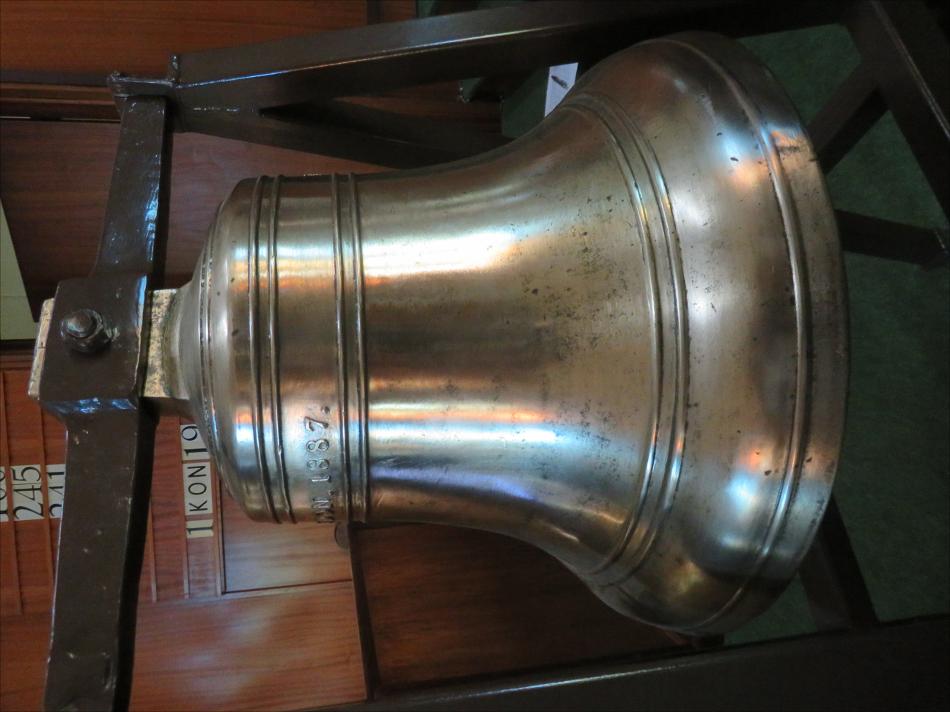Mossel Bay, Brandwacht, Dutch Reformed Church

View/
Author
Mears & Stainbank (Firm)
Petit & Fritsen (Firm)
Date Created
18871983
Format Extent
15 colour photographs1 spreadsheet
Rights
These items are subject to copyright protection. Reproduction of the content, or any part of it, other than for research, academic or non-commercial use is prohibited without prior consent from the copyright holder.Stellenbosch University
Metadata
Show full item recordAbstract
The current church dates from 1952 and was built next to the old one. The church has two bells, one inside the church, the other in the detached, white tower in front of the new church. The bell in the church was originally hanging in a detached horseshoe tower next to the old building. Because of the fear for theft, it was brought inside, carefully cleaned and put in a nice wooden frame. Just below the shoulder are two moulding wires and in between them: MEARS & STAINBANK, FOUNDERS, LONDON. 1887. Two further wires, one above the sound bow, the other on the lip conclude the decorations on this marvelously well-kept bell. George Mears owned and operated the Whitechapel Bell Foundry with his brother, John Mears, who managed the foundry at the time in 1859. George Mears' Great Grandfather, William Chapman Mears, was the first Mears to manage the foundry. His son, Thomas Mears Sr also managed the foundry, Thomas Mears Sr's son, Thomas Mears Jr bought it from the owners and handed his business down to his son, George Mears. By 1832 all 3 sons of Thomas Mears Jr., Charles, George & John, were working at the Whitechapel Foundry. In 1861 George Mears & John Mears went into business with Robert Stainbank as partner to form a company called Mears & Stainbank, the founder of the current bell. The family Hughes later got involved in the company that still exists today by the same name. The second bell is much younger and shows the traditional beautiful decorations found on the bells of the foundry. Below the shoulder one first finds a decorative band with flowers and angels playing the violin. Underneath this figures the information about the foundry, the year of founding and the suppliers. All around the bell one reads: GELEWER DEUR SUID AFRIKAANSE ORRELBOUERS (EDMS) BEPERK SILVERTON. PETIT & FRITSEN, AARLE-RIXTEL, HOLLAND 9267 + A.D. 1983. Three more moulding wires figure above the sound bow. On a side figures the pretty emblem of the foundry that shows a seal with three bells, one above, two underneath in between the branches of a tree. The emblem is surrounded by flowery branches. The number 9267 refers to a registration number in the order books of the company. From the early fifties of last century onwards, the Suid-Afrikaanse Orrelbouers (SAOB) started intensive business with the foundry Petit & Fritsen. Apart from the Western Cape, the foundry had a lot of business with other areas in South-Africa like Transvaal and the Pretoria region. While most orders came from the Nederduitse Gereformeerde Kerk, also orders from churches of other denominations have been registered. Often SAOB ordered sets of bells from P&F without giving information on their ultimate destination. This means that, even when we know the approximate date of delivery, it is an almost impossible task to try to find out where bells ultimately ended up. Fortunately, the foundry (almost) always put the founding year (here 1983) and the production number (here 9267) on its bells. The Royal Bell Foundry Petit & Fritsen is the third oldest family business in the whole of the Netherlands. It started operations in 1660 and remained one of the main bell founders in the world. In 2012 it was amalgamated with the Koninklijke Eijsbouts in Asten, the Netherlands.
Collections
- Mossel Bay [12]
